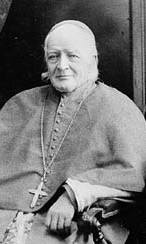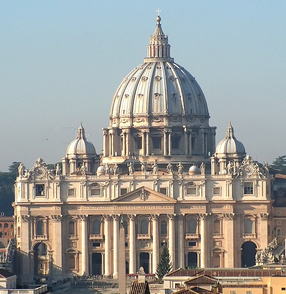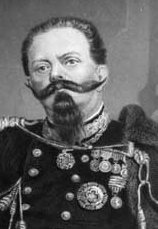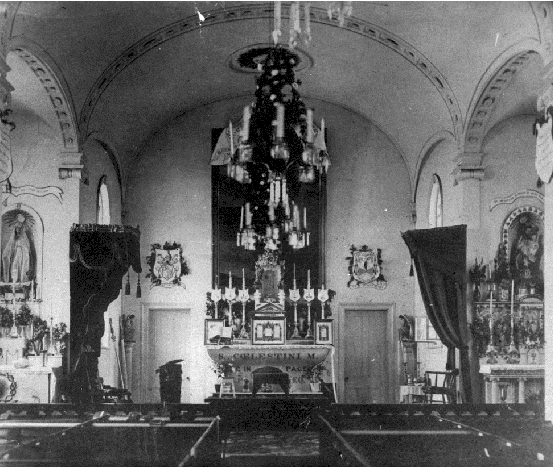Joseph Michaud was born in Saint-Louis de Kamouraska, Lower Canada (Quebec), on 1 April 1822. He studied classics at St. Anne College in Pocatiere, and he entered Les-Clercs-de-Saint-Viateur seminary in 1848.1 Upon the request of Bishop Modeste Demers
Bishop Modeste Demers, he traveled with the first four Sisters of St. Anne to British Columbia in 1858 (the same year as the Fraser River Gold Rush and the official creation of a British colony in mainland British Columbia).
Demers
Bishop Modeste Demers immediately tasked Michaud with the construction of British Columbia's first Catholic cathedral on Humboldt Street. Michaud designed and built St. Andrew's in an informal French Recollet style typical for rural churches in Quebec.2 Michaud was not a formally trained architect, and it was normal practice at the time for architects in Canada to copy existing models. Since he had not even been on the West Coast for a year yet, Michaud simply built St. Andrew's in the style he was familiar with. Inadvertently, Michaud started an important trend that would result in the construction of a French-Canadian space in Victoria.
St. Andrew's simple exterior was totally outdone by its extravagant interior. A journalist for the British Colonist newspaper (23 November 1860) believed that St. Andrew's was "built without much regard to the niceties of architectural design," but the writer still promised that the church would become "one of the most highly ornamented structures in the city" by the time Michaud was through.3 Michaud hand carved the wood of the interior with such skill, according to the reporter, that it could be mistaken for plaster. Michaud built St. Andrew's with California Redwood, and unbeknownst to the British Colonist he carefully structured the church within Catholic symbolism and numerology. The eight bi-sectioned windows represented the eight beatitudes of Christ and the two scriptures of the Christian Bible, and he carved five roundels into the ceiling with various Catholic devices.4
Demers
Bishop Modeste Demers ordained Michaud in the new cathedral in 1860 making Michaud the first Catholic priest ordained in British Columbia. Nonetheless, Michaud wanted to return home, which he did in 1862. Michaud, like so many of the transient people who built British Columia's infrastructure, was a sojourner, who left strong ties to Quebec when he left for the West Coast.5 Migration patterns to BC were also migration patterns outward, and Michaud stayed in Victoria and the Fraser Valley for only four years. However, he also established a permanent connection to British Columbia, and it is possible that Michaud's own travels in BC prompted his nephew, also named Joseph Michaud, to move to the Fraser Valley around 1877. Michaud returned to BC three more times, twice to visit his nephew.6
Once back in Canada East, Fr. Michaud began teaching at the college in Joliette, and he pioneered Quebecois post-secondary education in Physics.7 Meanwhile, the ultramontaneUltramontanism was a French-Canadian nationalist movement, which argued for a strong Catholic influence in culture and politics. bishop of Montreal, Ignace Bourget
Bishop Ignace Bourget, had convinced himself that the Catholic Church of Montreal needed to build a reduced-scale replica of St. Peter's Basilica in the Vatican City
St. Peter's, Rome. In 1857, Bourget
Bishop Ignace Bourget sent Victor Bourgeault, the leading French Canadian architect at the time, to Rome to study Michelangelo's Late Renaissance Baroque masterpiece, but Bourgeault returned with the opinion that it was inappropriate, not to mention impossible.8 Bourget
Bishop Ignace Bourget resurrected his plan in 1868, and at that point with the Papal states threatened by Victor Emmanuelle II's
Victor Emmanuelle II Italian unification mission, Bourget cast the project as a gesture of support for Rome.9 Bourget
Bishop Ignace Bourget sent Joseph Michaud to Rome with the Papal Zouaves, a volunteer army of Canadian Catholics traveling to Italy to protect the Papal states, and Michaud served in Rome as chaplain to an Algerian Army detachment.10 Michaud's real purpose in Rome was to study St. Peter's
St. Peter's, Rome, and he returned to Joliette in 1896 being shipwrecked along the way.11
Michaud constructed an impressive model over the next year for the new Cathedral in Montreal based on St. Peter's. It was 4.6m long, 2.8m wide, and 3m high.12 The bishop still commissioned Bourgeault to build the Cathedral, but Michaud's model was responsible for the overall direction of the project and proving that it was even possible.13
Fr. Joseph Michaud returned to teaching again, but he was not finished with architecture. In 1871 the Sisters of St. Ann in Victoria decided to build a new convent and school house, and Michaud designed it in absentia.14 Once again, Michaud was removed from trends in West Coast architecture, and he drew up plans for a building with a decidedly Quebecois flavour even though they did not conform specifically to any school of architecture.15 Charles Verheyden built the 1871 wing from Michaud's directions. Throughout the 1870s Michaud continued to practice architecture and teach at Joliette.
In 1880, the Church transferred Michaud to L'Institut des Sourds-Muets (Deaf and Mute Institute) in Montreal, which was directed by Michaud's order, Les-Clercs-de-Saint-Viateur.16 Construction on the Montreal basilica had started in 1875 and was well under way, but now Michaud was re-assigned to the team with Bourgeault and Alcibade Leprohon. After Bourgeault's death in 1888, Michaud became the principle architect on the project until the Cathedrale Saint-Jacques-le-Majeur was consecrated in 1894 (later renamed Cathedrale Marie-Reine-du-Monde).17
Michaud was a diligent, hard worker, and he designed many Churches along the St. Lawrence in Quebec as well as St. Joseph's in Vermont (1883), most of which he constructed in the Baroque style he pioneered.18 Michaud was an old man by the time he went to work on the Cathedral, but he still walked to work each day, since he carried some distaste for the tram.19 Fr. Michaud died in 1902, and he left behind the structures of a long architectural career. He was most remembered for the Cathedrale Saint-Jacques-le-Majeur and his coin collection, but Michaud had left a strong influence on nineteenth-century culture as far away as British Columbia.20









.png)

